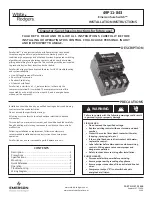
3
Description of
function
(modified 97-10)
Overload unit
The purpose of the overload unit is to protect
the capacitor bank against overload and har-
monic currents. The faults that may occur are
normally caused by overvoltages that may lead
to dielectric breakdown, i.e. short-circuit in an
capacitor element.
The phase currents I
L1
, I
L2
and I
L3
are filtered
with a damp factor directly proportional to the
frequency. Thus the input signals used will be
directly proportional to the voltage over the ca-
pacitor. The peak values, including harmonics,
are calculated from the input signals.
According to the standards (IEC 70) a high volt-
age capacitor shall be able to withstand 10 %
overload. This margin should be used only in
fault situations and during such operating con-
ditions which continue for a few days only.
The overload unit is designed for single-phase,
two phase or three-phase operation. It contains
two overload stages; I
a
> and I
b
>.
Note!
If the phase unbalance unit is used with com-
pensation the phase input I
L1
must be con-
nected.
If the current on one of the phases exceeds the
setting value of the stage I
a
>, the stage starts
and a timer ta is started. If the overload period
exceeds the set operating time, the stage pro-
vides an alarm signal. At the same time the dis-
play shows the red figure 1.
If the current on one of the phases exceeds the
setting value of stage I
b
> by 10%, the stage starts
and a timer is started. Simultaneously it pro-
vides a starting signal and the digital display on
the front panel indicates starting with the red
figure 2. The operation time depends on two
factors, the degree of overload and the inverse
time multiplier k. If the overload situation lasts
long enough to exceed the operating time, the
stage calls for CB tripping by providing a trip-
ping signal. At the same time the operation in-
dicator goes on with a red light and the display
shows the red figure 3. The indicators are reset
with the RESET push-button.
The operation of both overload stages can be
blocked by bringing a blocking signal BS1, BS2
or RRES to the unit. The blocking configura-
tion is set by means of switchgroups SGB1...3.
The starting setting range of the overload stage
I
b
> is 0.30...1.50 x I
n
. The operation of stage
I
b
> is based on an inverse time characteristic.
The inverse curve is using an ANSI-curve for
time/current characteristics.
The starting setting range of the overload stage
I
a
> is 80...120% I
b
>. The operating time ta> of
the stage is set separately within the range
0.5...100 min.
Fig.1. Filtercharacteristic for filtered phase cur-
rent inputs I
L1
, I
L2
and I
L3
.
The operation of overload stage I
b
> is provided
with a latching facility (SGB1/6) keeping the
tripping output energized, although the signal
which caused the operation disappears. The
output relays may be reset in five different ways;
a) by pressing the PROGRAM push-button, b)
by pressing the RESET and PROGRAM push-
buttons simultaneously, by remote control over
the SPA bus using c) the command V101 or
δ
)
the command V102 and further e) by remote
control over the external control input. When
resetting according to a) or c) no stored data
will be erased, but when resetting according to
b), d) or e) the recorded data will be erased.
10
5
0
-5
-10
-15
-20
-25
0 1
3 4 5 6 7 8 9 10 11 12 13 14
2
dB
f/fn
















































